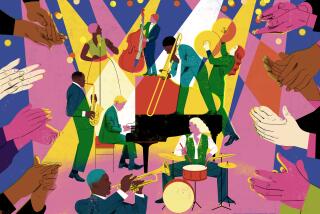STAGE REVIEW : Cameo Appearances Enliven Dull Tribute to Jazz Era
- Share via
SAN DIEGO — When the Cotton Club was king, Cab Calloway and the tap-happy young Nicholas Brothers were among the show business greats who kept the Harlem joint jumpin’.
Calloway and the Nicholas Brothers were at the forefront again during the golden age of movie musicals. But, when tastes changed, the giants of jazz music and dance virtually disappeared from the mainstream.
Too bad that when they finally got together for a gig (after almost half a century), it was for the inauspicious and obviously exploitative variety show, “Gotta Sing Gotta Dance.” The show checked in for a best-forgotten weekend run at the Civic Theater.
The legendary “Hi-De-Ho Man” and those consummate hoofers, the Nicholas Brothers, can still hold an audience in the palm of their hands. And they did just that at Friday’s opener. However, as is usually the case with such enterprises, the stellar attractions made only cameo appearances. The rest of the cast--with a couple of exceptions--ranged from sorely inept to only mildly entertaining in this muddled mix of vaudeville acts and burlesque-style slapstick shticks.
The best of the lot was a blues singer named Marilyn Walton who belted out the songs with a finely tuned voice that just wouldn’t quit. Unfortunately, an errant sound system that brought the technical level at the Civic Theater to a new nadir, nearly destroyed her performance Friday night.
In the midst of her bluer than blue rendition of “My Man”--the ultimate ode to obsessive love--a body mike that refused to function during the performance, suddenly came alive from off stage. The jolting interference evoked titters from the audience, but the singer went on to earn an ovation nonetheless.
Ray Bolger-style dancer Betsy Baytos had her moments with the wobbly-armed, rubber-legged brand of dancing she learned at the master’s feet, and San Diego’s own Kirby Ward did some dandy tap routines. But the balance of the dancing was more of a parody of the fleet-footed tap dance era than a salute to it.
The Nicholas Brothers showed up just before intermission, and stopped the show with the same stylish routine they did for the dance awards show at the Convention Center a short time ago. And their smooth-as-silk style was as disarming as ever.
They did not even try to reproduce the gravity-defying antics they performed with such bravado in a host of movie musicals. They stuck to the free and easy rat-tat-tap routines that flow like molasses, and showed that style and elegance are independent of youthful verve.
The brothers can still move with speed and agility, thank you. And they demonstrated a little of that as well--without the acrobatic derring-do they dished out in their early years. A sample of those early pyrotechnics came from an old movie clip that was shown during the performance. And it brought down the house.
The near-capacity crowd had to wait more than two hours for Calloway to get into the act, but when he showed up for his set, it was bedlam. By the time the Hi-De-Ho Man had finished his signature song--”Minnie the Moocher”--the audience was on its feet and bursting with enthusiasm.
Most in the crowd had yet to be born when these old pros were at their peak, but the large complement of students on hand was even more enthralled with the performance than the nostalgia set.
The show featured live music from the Rhythm Kings band, but it was a far cry from the Big Band sounds of the ‘30s and ‘40s. Likewise for the lifeless production numbers. Even the curtain-raiser, a pseudo-risque speak-easy vignette (complete with flappers and a police raid) fell flat.
This misguided paean to the Jazz Age, presented as the final attraction in the San Diego Foundation for the Performing Arts’ series, listed a tap challenge for the finale. And an all-out dance-a-thon might have perked things up a lot.
However, all the show delivered was an uninspired ensemble piece. Calloway never even returned to participate in this full-company work (although he was listed on the program as the singer).
“Gotta Sing Gotta Dance” flaunted some of the trappings and trademarks of a bygone era. It even found a spot for a virtuoso banjo performance. But the show lacked energy and pizazz. And, except for a handful of dazzling powerhouses, the production was hard-pressed for talent--despite the huge roster.
More to Read
The biggest entertainment stories
Get our big stories about Hollywood, film, television, music, arts, culture and more right in your inbox as soon as they publish.
You may occasionally receive promotional content from the Los Angeles Times.










